My goal of doing the Molokai started in 2004 after reading an article on the race entitled “Waves the size of small houses” by Peter Gimple in Hullspeed. The article really captured the essence of the race and I must have read and reread it 20 times over the years. I was determined to make it there someday and May 16th, 2010 turned out to be that someday.
First Hawaiian downwind run – Hawaii Kai to Outrigger Club Waikiki.
The put in spot in Hawaii Kai is in protected waters and a great spot to start my first Hawaiian paddle. I was paddling with Tim Burke, from Annapolis, MD. He has been to Hawaii several times and was showing me the ropes. Tim and I first met on a police boat in NYC after our barge incident, but that is a different story.
The wind was blowing pretty strongly and I was fairly nervous initially. We started heading perpendicular to the wind towards China Wall to get a better angle at our downwind run. I asked Tim “How long before I no longer feel like a frightened little girl?” He said that feeling never really goes away completely….that was not the answer I was looking for. My heart rate was 160 and I was hardly exerting myself. We were still in the protected waters off Hawaii Kai so the conditions were no big deal but the winds were very strong and I knew what was in store once we got out into open waters. As we started to enter the more open waters and after the I asked Tim for the 3rd time if we could turn now, he finally said yes. A rain squall came screaming through with winds gusts strong enough to rip the paddle from your hands and Tim suggested we wait a minute for the squall to pass through and I eagerly agreed. The squall was gone in less than in a minute and the winds dropped back down to 20 knots. We headed out and I talked myself into thinking that the conditions were really just like a challenging day on Long Island sound, except that the waves were 2-3 ft bigger than the 2-3 footers we occasionally get. As I become more comfortable I started doing better and it was actually easier than what I expected. This run was definitely doable in the V10 Sport. There were times when I would be in front of Tim and other times he would be 100+ yards out in front of me. We stayed in reasonable proximity to each other, but I knew that if I went for a swim I would be on my own to remount. It would have been wise to practice a remount in these conditions, but my first day was not the time to do that voluntarily. I told myself that if I didn’t go for a swim, I was not being aggressive enough…ironically, this helped my technique and I didn’t swim.
When catching the runs, I would consistently notice that the holes I would aim for would no longer be there by the time I got there. Faster running waves were coming in from the open ocean at a little different angle then the one I was on and impede my progress. Tim suggested that I try turning sooner and accelerating to get in front of these…easier said than done.
Overall, I followed a sprint, rest, sprint, rest pattern. On the runs when I got up to speeds over 10 mph I noticed that when put my blade in the water in front of me it would sometimes get jammed right back me as I was not being quick enough. Think of jumping out of a moving car…your feet hit the ground but you keep moving, the same with a paddle in the water.
When the sun shown down on the deep water, it was an amazing deep blue, when we paddled over less deep, sandy spots, the water color would change to a light blue. This is truly incredible and something that is best appreciated first hand.
Tim had instructed me to paddle to the big red can off Diamond Head where we were to meet up and then we were to turn in towards the wind sock off the outrigger club. This worked out well. Diamond Head creates a wind shadow and as you bend around the corner of the island towards Waikiki, the water gets shallower and the waves mellow out quickly. There are several reefs along the way which create easily rideable waves and we both caught a few.
We pulled our boats into the Outrigger Canoe Club and I was very satisfied with how things went. In my mind, I increased my chances of finishing Molokai to 90% up from 75%.
The Outrigger Canoe Club (OCC) was one of my favorite parts of whole trip. Think of it was a golf country club, but for paddlers, right on the beach at the end of Waikiki. It has a small sandy beach, locker rooms, facilities for washing off the boat as well as rack storage. Most importantly, it was a great restaurant where you can eat Mahi Mahi sandwiches and drink beer overlooking the ocean.
Tim and I repeated the Hawaii Kai to Outrigger Club run the next day and I was less nervous and did much better.
Makapu’u Run – Unofficial Race
Due to a lack of a support boat and a limited number of paddlers on the island, the Makapu’u race, which is typically held 1 week before the Molokai, became an unofficial practice run.
We met up at the Outrigger club and loaded a dozen skis on a trailer and Geoff Graf drove us out to the Makapu’u Research Pier.
Makapu’u is a tall headland on the north eastern corner of the island and the 16+ mile race is from the Pier to the Outrigger Club in Waikiki. We put in, had quick countdown and away we went into a strong headwind. The waves quickly grew in size as headed out of the lee of Shark Island. It wasn’t long before they were well over 6 feet and the seas were becoming increasingly more confused. Sit on the floor and look up at the ceiling, that is what the size of the waves looked like. These waves would occasionally crumble and 18” of whitewater would hit my boat from the side. Like China Wall further down the coast, the waves would crash into the cliffs of Makapuu point and bounce back in an unsettling manner. I headed out to sea to try and minimize the effect of the wall and to give myself more time in the likely event of a swim. If you couldn’t remount your ski, the strong winds and the sizeable waves would push you onto the rocks and it would be easy to lose more than a ski.
I was floundering about, not moving very fast and taking very short, inefficient strokes. After passing the typical turning point, an OC-1 paddler who started late came up from behind me and asked “Where the hell I was going…you need to turn now” I shouted that I wanted to go further out to sea, but I am not sure what he heard over the 20+ knot wind. He took off and I realized too late I should have offered him a $100 to escort me past China Wall.
Because of my hesitant technique, I was moving very slowly (less than 5mph) and I quickly lost sight of the other paddlers. I somehow remained upright and things became more manageable both technically and psychologically when I was off Sandy Beach. I even got in some 12 mph, “Oh my god” runs. The seas became challenging again off China Wall and I struggled once more, but once past the wall, things were easier. What remained was the Hawaii Kai to OCC run that I had done the prior two days, so I told myself not be such as wimp and continued on towards the can off Diamond Head. My pace improved dramatically and I was now moving in the 6 – 8 mph range.
After putting my boat away and showering at the OCC, I sat down at the restaurant and ordered two large Sierra Nevada’s and two large waters. The waitress placed one set in front of me and one set in front of the empty chair next to me. I told her that they were all for me and 10 minutes later, gazing out onto the ocean, I had 4 empty glasses in front of me and all was right with the world again.
Walking back to the Park Shore hotel, I met Ken Vidler, from Perth. Ken looked to be in his early 50s and has a significant surplus around his waist. Ken was very nice and told me he started paddling again after many years and has been training for 3 months for Molokai. This was somewhat crushing given that he came in ahead of me and that I had been training for Molokai for more than a year. He subsequently told me that 25+ years ago he was the best in the world at lifesaving surfski racing and had competed in the Olympics. I felt much better.
Coaching Session with Dean Gardner
Knowing that I needed help my surfski surfing technique, I had arranged for a coaching session with course record holder and 9 times Molokai Champion Dean Gardner. I had suggest that we go up to Hawaii Kai, but Dean wanted to go off OCC/Diamond Head Can as there was “too much going on up at China Wall” and it would be better to teach technique in more orderly waters. He said to meet up at the OCC at 4:00. I don’t know if it was luck, skill or maybe Dean talked to Poseidon, but there were big glassy waves jacking up on the reefs off the Outrigger Club…the best I had seen there all week. These waves were well defined and generally easy to catch with Dean shouting to wait or to “sprint now”. I got on the biggest one of the day and was flying down the face as it grew and grew. I was dragging my paddle in the brace position and Tom McTigue, who was on the same wave about 30 feet to my left, told to me to start paddling again. I put the paddle in the water at the catch and I was instantaneously ripped off the boat. The water felt great and I had a big smile on my face as I remounted the boat.
We met for beers at the OCC after the coaching session and Dean told us that in the race, the swells from the southeast and the local trade wind waves from the northeast would combine to make “A frames”. Surf a few wind waves to Southwest, then use your speed to get on a swell and take that to move further north. Great advice if you are skilled enough to apply it on the water. I knew I wasn’t fast enough to get on a swell other than by luck, but it was good to know. We continued to drink beers into the dark and this evening was one of the highlights of the trip.
The race
I can put a lot of pressure on myself, and for several days after the drubbing I got at Makapu’u, I was a little worried about completing the race. I found it ironic that I was somewhat dreading something that I have been looking forward to and training for…for such a long time. I wasn’t concerned about my safety, but the enormity of the task and hand and not being able to accomplish it. The day before the race I decided I needed a massage and my wife arranged for one at Kahala Hotel while she and my girls swam with their Dolphins. The hotel’s spa was amazing and after receiving the best massage of my life, my attitude had changed completely.
Despite hours of flight delays, the flight over to Molokai on a twin engine plane was cool. The channel looked both enormous and small at the same time. Enormous when you thought of it on a human scale, but small when compared to the surrounding Pacific. The ocean was deep blue but covered with whitecaps, which look like bits of floating icebergs from above.
After getting settled, we went down to the beach in the dark to check things out and the sky was absolutely amazing. The only light pollution was coming from the units themselves and a few escort boats in the harbor. Some Australians were camping down on the beach and the whole scene was very peaceful. The lights of Oahu reflecting off the clouds were visible in the distance.
The next morning I went to find my boat and they were all lined up like white sardines. Prepping for the race was fun and the serenity of my massage was still working its magic. Everyone was both excited and friendly. Ed Joy and I had a wonderful conversation on the optimal technique for duct taping GU to a ski.
My friends Bob and Rob (aka Creature) were responsible for finding my escort boat and bringing our crap out it as well as getting themselves on it. To get out to the escort boat, you have to either swim or get a ride on one of two jet skis with a lifesaving rack with handholds on the back. Rob got on the rack first and didn’t get enough of his body out of the water. He had a very hard time keeping his shorts on as he was dragged through the water.
When the race started, the top guys shot out of there like you wouldn’t believe, especially considering it is a 32 mile race. I tried to stay as far to the right of the crowd as possible per Glicker’s advice.
The escort boats didn’t seem to wait the 20 minutes they are supposed to and I had to contend with some waves and wakes mixed together, but it wasn’t too bad. My pace was in the 6.8 – 7.5 mph range without working too hard as I was getting a good push from the wind. As we got further from Molokai, the ocean quickly became livelier and I caught some decent runs, but the good runs started taking me south of the desired line. I hit 12+ mph on one run and similar speeds on others, but I had to focus and didn’t look down at the GPS.
Oahu grew quickly in size and I was generally feeling positive and thinking I would have a good finishing time…maybe break 5 hours, when I went for my first swim. I remounted quickly and was on my way again, but I was missing my favorite hat. I was hoping this offering to ocean gods would appease them, but this was not the case.
I could catch good runs if I headed too far south, but I struggled to catch a run and surf to the right as instructed and keep on course. Things started to degrade slowly as I tried to work my way more to the north to stay on the proper line. At this angle, the runs were more difficult to catch and it seemed that the wind waves were directly on beam and I went for a few more swims.
I knew my Camelback wasn’t empty, but for some reason, I wasn’t getting any liquid from it, so I waved the boat up to do the water drop somewhere around the 14 mile mark. Creature and I had rehearsed this and it generally went as planned. He jumped in the water with a replacement Camelback and swam up to my boat and we swapped them out. I had to thread the hose through some plastic loops I had duct taped on and then I was on my way. I drank heavily as I wanted to stay hydrated.
During the race I really got a kick out of watching the flying fish, which look just like they do on the Molokai Challenge Logo. They glide a few feet off the water for over 100 feet at a time and can even steer in the air using their fins.
I went through a period of about an hour where it seemed like I was climbing uphill or stalling the whole time. The nose of the ski would be point up, so I would back off, as it would drop I would take a few strokes and either I would get a short push then nose into the wave in front of me, or the wave would pass under me and swamp my bucket. I couldn’t seem to catch a real ride and surf to the right to keep on track. Sometimes the pearling was significant and I would loose control of the boat and I would go for another swim. As the seas grew, remounting became more difficult and it would often take a 2-3 tries to get back on the boat. This was definitely slowing me down. My stall, stall, stall pace wasn’t very good and 18 miles into it, I knew the odds were no longer in my favor.
Over time, my ability to recover from an unstable position via some quick bracing was greatly diminished and I would go for a swim. Upon remounting I was getting very twitchy and while I still had some gas in the tank, by mile 20, I knew I was done for. I just needed to rack up a few more miles and, maybe somehow get into the calmer waters of Hawaii Kai…if I could ever get past China Wall with no stability that is. After a difficult remount, with the hopes of finishing the race fading, I became very pissed off and with nothing to loose, I sprinted full speed down a wave and shot forward at 10+ mph and maintained a great pace for a little while longer. Who cares that I wasn’t heading on course; at least I wasn’t stalling or swimming. My balance was completely done for and it wasn’t long before my paddle got caught on a wave behind me and I was in the water once more. I decided to drop out after my next swim, I told the escort boat I was done, but I wanted to try to get just a little further. Given how unstable I was, this swim was only a half mile later and I climbed onto the boat after 23 miles without remorse…I knew I had done my best and that I would return someday to complete my goal. This was simply a stepping stone to get there.
The boat ride into Hawaii Kai was fun and I rode in with a smile on my face. The escort boat driver would speed up and slow down to surf the waves. I am not sure who it was, but we passed one paddler about a half mile off of China Wall and he looked completely fried. He was paddling so slowly I don’t know how he stayed upright. In the protected waters of Hawaii Kai, about one mile from the finish line, I joked with the escort captain “You can just let me off right here”
The beer at the party after the race tasted fabulous and I kept thinking that we just don’t get theses conditions to train on in Connecticut. I am TOTALLY impressed with Tim Burke and Richard Germain. While some may discount finishing Molokai in a flat year, there is no discounting the 2010 conditions and what it takes to finish.
Lessons Learned
Since the race, I have gone over dropping out of the race countless times in my head, questioning myself as to whether I could have finished the race. The simple answer is no, crossing the Molokai channel is not like running a marathon or other endurance sports where, if your willing to endure pain, you can continue to crawl along indefinitely. The channel will not allow that. It requires technical skill and the speed and endurance to deliver that skill again and again for 32 miles. Because my limited surfing experience and skill, I ended up working harder and fatigued my abdominal stabilizer muscles to the point where they were no longer responding adequately.
I read a triathlon training article which said to eliminate the showstoppers. It focused on hydration, heat exhaustion, bonking, chaffing and the usual stuff. This advice resonated with me, but I didn’t apply properly and eliminate all of the showstoppers by doing sport specific balance training such as padding my seat up.
Developing surfing skills requires that you have frequent access to rough waters. In Southwestern CT, we don’t get these conditions unless there is a storm. I significantly underestimated how quickly I could pick that up these skills once out in Hawaii. Joe Glickman tried to convey this in an email around Christmas time (Hanukah for Joe), but other than flying somewhere warm and windy, there was not much I can do differently. One thing that Glicker certainly stressed was to train 10 strokes all out and 20 stokes recovery for hours on end to simulate the physical demands of the race and this is certainly great advice. It is simply a different type of fitness required than paddling the Blackburn or the Run of the Charles. Molokai can best be described as (US Surfski Champs + 2 feet X 2 distance) + 20 degrees.
I think that it is spectacular that a race exists which is so incredibly demanding both physically and technically, yet still obtainable by non-elite paddlers, all set in such a beautiful and amazing place. I will be back again some day once my wallet recovers. ~ Tom
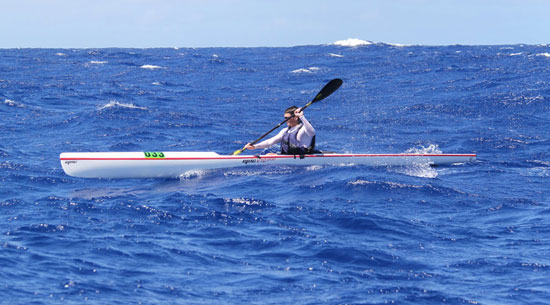









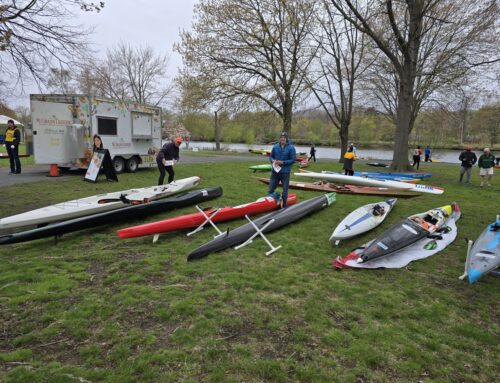
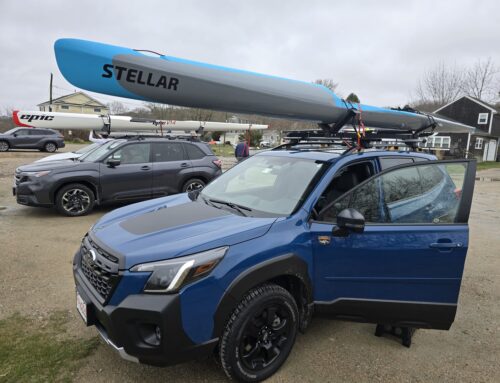
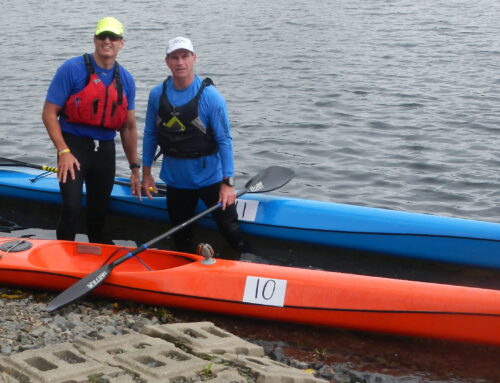
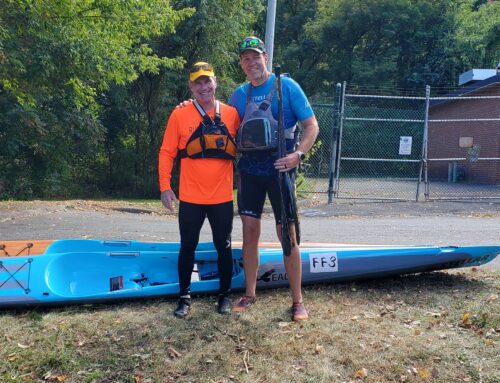
Leave A Comment
You must be logged in to post a comment.